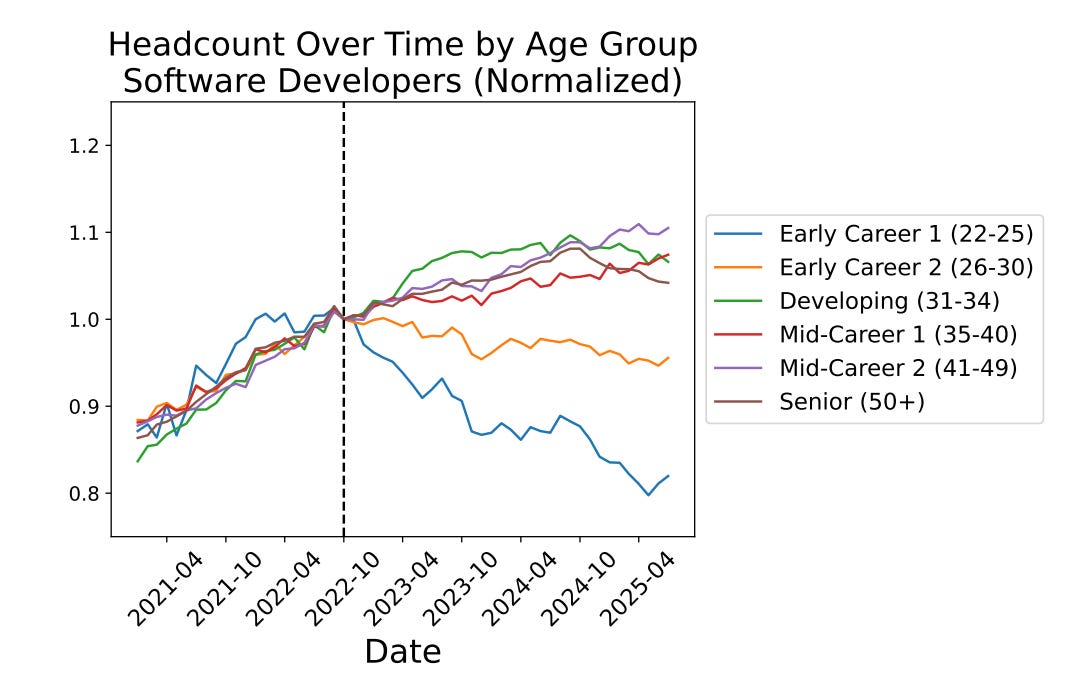The vanishing first rung: How AI is hollowing out entry-level jobs
For generations, careers have begun the same way. You took an entry-level role, slogged through repetitive tasks, and slowly built the skills that prepared you for more responsibility. The work wasn’t glamorous, but it was essential — it was the first rung on the ladder.
Artificial intelligence is removing that rung.
New research from Stanford economists Erik Brynjolfsson, Bharat Chandar, and Ruyu Chen - see the Canaries in the Coal Mine paper. - shows employment among 22- to 25-year-olds in AI-exposed jobs has dropped sharply since late 2022. In software development, headcount for that group is down nearly 20 percent. Customer service and translation show similar patterns. Older workers in the same jobs are largely unaffected.
The explanation is clear: AI is replacing codified, rules-based tasks — exactly the kind that once defined entry-level work — while leaving tacit, experience-based skills intact. The result is fewer opportunities for new graduates trying to gain a foothold in the labor market.
Not everyone accepts this as inevitable. Matt Garman, the new CEO of Amazon Web Services, has called the idea of cutting junior developers “one of the dumbest things I’ve ever heard.” His reasoning is simple: junior employees are the cheapest on the payroll, they are “AI-native” — already comfortable with the tools — and they form the pipeline for tomorrow’s leaders. Stop hiring them today, and in ten years you’ll have no bench.
It’s a compelling argument, but it has limits. Being “AI-native” doesn’t automatically make someone effective. A novice carpenter with a set of power tools won’t suddenly produce masterwork furniture. Without experience, they may misuse the tools, make errors they can’t diagnose, or fail to see how the pieces fit together. The same tools in the hands of a skilled carpenter, however, produce extraordinary results. AI is no different. Pair it with senior developers and the output is amplified; pair it with juniors lacking context and the result can be brittle or even harmful. AI plus seniors is far greater than AI plus juniors.
So what now? If AI has automated away the first rung of the ladder, how do we create new ways for people to climb? Two paths stand out.
First, universities and the education system must adapt. Relying on entry-level jobs to serve as training grounds is no longer viable. Schools need to prepare students for a higher starting point, emphasizing problem framing, system design, and AI supervision instead of rote coding or repetitive analysis. The missing rung must be rebuilt in the classroom.
Second, companies must resist the temptation to cut off entry-level hiring. Business continuity depends on a steady pipeline of talent. Even if juniors are less effective with AI today, firms cannot afford to leave the bench empty. Structured programs, apprenticeships, and explicit training can help bridge the gap, ensuring that new entrants still accumulate the tacit skills machines cannot provide.
Back to school. Why college recruiting should be part of your scaling efforts
In the previous post I outlined some of the challenges an engineering organization will face as it scales. This post will address one of the main elements of scaling an engineering team: recruiting.
AI has made intelligence abundant, but experience remains scarce. Eliminating the first rung of the ladder leaves the entire structure unstable. If universities reimagine how they prepare students, and if companies continue to invest in new talent, the ladder can be rebuilt.
If not, abundance risks becoming exclusion — a world where opportunity exists only for those who already sit at the top, and that’s very short-sighted.




